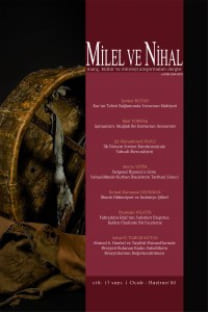Şehristânî'ye Göre Kur'ân'ın Sırları: Bir Ön Değerlendirme
Muhammed b. Abdülkerim eş-Şehristânî (ö. 548/1153) Selçuklu döneminin temel entelektüel temsilcilerinden birisi olarak kabul edilmektedir. Hayatının sonlarına doğru Şehristânî Mefâtîhu’l-esrâr isimli bir Kur’ân tefsiri yazmaya başlamıştır. Bu eser, güçlü bir şekilde, Şehristânî’nin daha özel dinî görüşlerinin bariz aşırılığını doğrulamaktadır. Sözkonusu eser, her bir âyeti bir dizi başlık altında (sözlükbilimden [ilmü’l-luğa], geleneksel olarak rivayet edilen tefsirler [tefsîr bi’l-me’sûr] ve yüksek yorumlara [te’vîl] kadar) tartışan kapsamlı (câmi‘) bir çalışmadır. Yazar tarafından ‘âyetlerin sırları’ (esrâru’l-âyât) olarak isimlendirilen son bölümler, kutsal kitabın derinde yatan aklîliğini ve iç tutarlılığını ortaya koyan, Kur’ân’a dair sistematik bir te’vil geliştirmektedir. Bu te’vil sisteminin anahtar ilkeleri, Şehristânî tarafından bütünüyle, tefsirin hacimli girişinde tartışılmıştır. Özellikle Guy Monnot ve Diane Steigerwald gibi pek çok Batılı ilim adamı, sözkonusu düşüncelerin büyük oranda Fâtımî İsmailî öğretiden etkilendiğini ileri sürmekte ve bu görüşlerini, çağdaşları tarafından Şehristânî’nin ‘dağ kalesindekilere’ karşı bir özel bir yakınlık beslediğine dair iddiaları yoluyla desteklemektedirler. Bunun neticesi, Gazâlî gibi bir isim özelinde Şâfi‘î ve Eş‘arîliğe intisabın, tasavvuf tarafından batınî anlamda tamamlanması gibi, bazı İsmailî irfanî unsurlar da, Şehristânî özelinde aynı bağlılıkları benzer bir şekilde tamamlamışlardır. Bu çalışmada ben, sözkonusu te’vil kavramlarını bir bütün olarak incelemekte ve bunu yaparken de Şehristânî’nin tefsirine yazdığı girişlere ve Fâtiha suresi tefsirine dayanmaktayım.
Shahrastânî on the Arcana of the Qur’an: A Preliminary Evaluation
Muhammad ibn ‘Abd al-Karim al-Shahrastani (d. 548/1153) is considered a major intellectual representative of the Seljuq period. Towards the end of his life Shahrastani began writing a Qur’anic commentary, the Mafatih al-asrar. This work strongly confirms the brilliant radicalism of Shahrastani’s more private religious views. It is a comprehensive (jami‘) commentary which discusses each verse under a series of headings, from lexicography (‘ilm al-lugha) to conventional transmitted exegesis (tafsir bi’l-ma’thur), to higher interpretations (ta‘wil). The latter sections – titled the ‘arcana of the verses’ (asrar al-ayat) by the author – develop a systematic hermeneutic of the Qur’an which reveals the scripture’s deep underlying intelligibility and self-consistency. The key principles of this system of interpretation are fully discussed by Shahrastani in his lengthy introduction to the commentary. A number of Western scholars, notably Guy Monnot and Diane Steigerwald, argue that the body of ideas in question is strongly influenced by Fatimi Isma‘ili doctrine, thus supporting what a number of contemporaries claimed about Shahrastani: that he harboured a private sympathy for ‘the people of the mountain fortresses’. The upshot of this appears to be that, just as Sufism formed the esoteric complement of Shafi‘i and Ash‘ari communal affiliations in the case of a figure like Ghazali, some kind of Isma‘ili gnosis formed a similar complement to the same affiliations in the case of Shahrastani. The upshot of this appears to be that, just as Sufism formed the esoteric complement of Shafi‘i and Ash‘ari communal affiliations in the case of a figure like Ghazali, some kind of Isma‘ili gnosis formed a similar complement to the same affiliations in the case of Shahrastani. In this paper I explore the body of hermeneutical concepts in question, based on Shahrastani’s introductions to his commentary and on his exegesis of Surat al-Fatiha.
Keywords:
-,
- ISSN: 1304-5482
- Yayın Aralığı: Yılda 2 Sayı
- Başlangıç: 2003
- Yayıncı: Milel ve Nihal: Eğitim, Kültür ve Düşünce Platformu Derneği
Sayıdaki Diğer Makaleler
Struggling with the Philosopher, A Refutation of Avicenna's Metaphysics
Abdülkerim eş-Şehristânî'nin İslam Mezheplerini Tasnif Metodu
Zorunlu Varlığın Bilgisi ve Tümel ve Tikel ile İlişkisi
The Mystery of the Historical Jesus
Şehristanî'nin El-Milel ve'n Nihal Adlı Eserinde Dinler Tarihine Dair Kullandığı Metodlar
İblîs'in Kötülük Problemi'ne Dair Felsefî Argümanları ve Şehristânî'nin “Bilinemezcilik” Teodisesi
A Guide to the Phenomenology of Religion
Tanrı'nın Asi Çocukları: Zalimlik ve Mazlumluk Arasında Şiddet Sarmalındaki Yahudiler
Şehristânî'ye Göre Kur'ân'ın Sırları: Bir Ön Değerlendirme
Şehristânî'nin Felsefeye ve Filozoflara Bakışı: Felsefe Tarihinden Felsefî Hesaplaşmaya
